|
|
||||
|
Published by : PROFESSIONAL MEDICAL PUBLICATIONS |
||||
|
ISSN 1681-715X |
||||
|
||||
|
- |
||||
|
ORIGINAL ARTICLE |
||||
|
- |
||||
|
Volume 24 |
April - June 2008 (Part-II) |
Number 3 |
||
|
|
||||
|
||||
|
|
||||
|
Published by : PROFESSIONAL MEDICAL PUBLICATIONS |
||||
|
ISSN 1681-715X |
||||
|
||||
|
- |
||||
|
ORIGINAL ARTICLE |
||||
|
- |
||||
|
Volume 24 |
April - June 2008 (Part-II) |
Number 3 |
||
|
|
||||
|
||||
Histopathological Audit of Goiter:
A Study of 998 Thyroid Lesions
Uzma Bukhari1, Saleem Sadiq2
ABSTRACT
Objective: Nodular goiter is the commonest lesion of thyroid gland. This study was carried out to see histopathological pattern of thyroid enlargement.
Methodology: All thyroid lesions received in the Department of Pathology, Basic Medical Sciences Institute, Jinnah Postgraduate Medical Centre Karachi, over a period of five years were reviewed and relevant special stains were performed.
Results: A total of 998 lesions were reviewed. Seven hundred forty three cases were found non-neoplastic and 255 were neoplastic lesions. Multinodular goiter was found to be the commonest 91.3% non-neoplastic lesion. In neoplastic lesions, there were 102 benign lesions and 153 were malignant. All 102 benign lesions were diagnosed as follicular adenoma as per existing criteria. Out of these, 35 cases showed questionable nuclear changes, which were categorized as well-differentiated tumours of uncertain malignant potential. Papillary carcinoma was the commonest malignant lesion with a total of 138 cases.
Conclusion: The commonest cause of goiter was multinodular goiter. Papillary carcinoma was the commonest malignant lesion.
KEY WORDS: Multinodular goiter, Follicular adenoma, Well-differentiated tumours of uncertain malignant potential, Papillary carcinoma.
Pak J Med Sci April - June 2008 (Part-II) Vol. 24 No. 3 442-446
How to cite this article:
Bukhari U, Sadiq S. Histopathological Audit of Goiter: A Study of 998 Thyroid Lesions. Pak J Med Sci 2008;24(3):442-6.
1. Dr. Uzma Bukhari, MBBS, M.Phil
(Histopathology)
Assistant Professor,
Pathology Department,
Muhammad Medical College,
Mirpurkhas – Pakistan.
2. Prof. Saleem Sadiq, MBBS, M.Phil (Histopathology)
Pathology Department,
Basic Medical Sciences Institute,
Jinnah Postgraduate Medical Centre,
Karachi – Pakistan.
Correspondence
Dr. Uzma Bukhari,
E-mail: uuzmasyed@yahoo.com
* Received for Publication: January 9, 2008
* Accepted: April 3, 2008
INTRODUCTION
Thyroid enlargement is one of the most common disorder of the endocrine system. Goiter is an enlarged thyroid gland.
1 Goiter though a world wide problem is endemic in mountainous regions of the world. In Pakistan it is particularly prevalent in Northern areas of the country situated in the base of Himalayas, which are iodine deficient areas.2Long-standing goiter (for more than 5 years) is regarded as the strongest risk factor for thyroid carcinoma.
1 According to Abu Eshy et al3 and Hussain et al,4 the commonest cause of thyroid enlargement is multinodular goiter followed by thyroid tumours.Tumours of the thyroid characterized by follicular growth pattern constitute the most common type of lesion of this organ encountered by Pathologists. A frequent problem posed by encapsulated follicular patterned lesions in which the nuclear changes of papillary carcinoma are only present focally or are questionable.
5 Chernobyl Pathologists Group categorized these tumours as well-differentiated tumours of uncertain malignant potential (WDT-UMP) i.e, encapsulated tumours with questionable nuclear changes and no capsular or vascular invasions.6,7Thyroid tumours are more frequent in women than men. Most tumours (about 80%) of the follicular cells are benign, that is adenomas. Carcinomas represent the most common form of endocrine gland malignancy.
8The aim of our study was to see the frequency and morphological pattern of thyroid lesions in thyroidectomy specimens received in the department.
METHODOLOGY
The present study included all the thyroid lesions, which were diagnosed in the Department of Pathology, Basic Medical Sciences Institute, Jinnah Postgraduate Medical Centre, Karachi over a five years period from 2000 to 2005. Total number of cases was 998. The hematoxylin and eosin (H&E) stained sections were reviewed and relevant special stains like PAS, Congo-red & Trichrome were performed to help in reaching a specific diagnosis. In all statistical analysis only P values <0.05 were considered significant.
RESULTS
We reviewed 998 thyroid lesions. Out of these 743 (74%) were non-neoplastic lesions and 255 (26%) were neoplastic. In non-neoplastic lesions, multinodular goiter (Fig -1) was found to be the commonest lesion with a frequency of 678 (91.3%) followed by lymphocytic thyroiditis 30 (4.03%), benign cyst 25 (3.4%), hashimoto’s thyroiditis 8 (1.07%) & primary thyroid hyperplasia 2 (0.3%) Table-I.
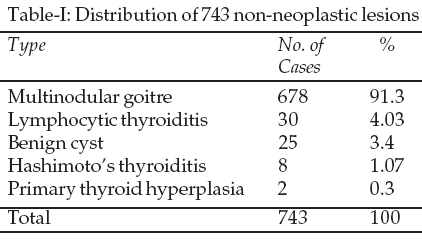
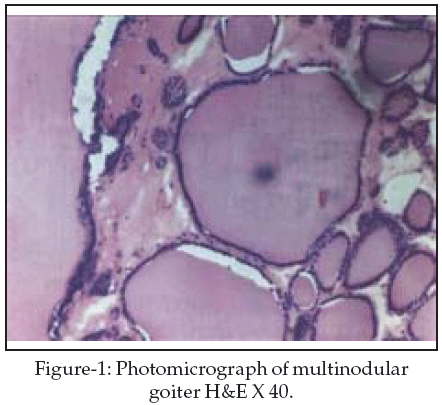
In a total of 255 neoplastic lesions, 102 (40%) were benign and 153 (60%) were found to be malignant (Table-II). A high frequency of benign and malignant neoplastic lesions was seen in females with a total of 199 (78%) cases as compared to 56 (22%) males with female to male ratio of 3.6:1.
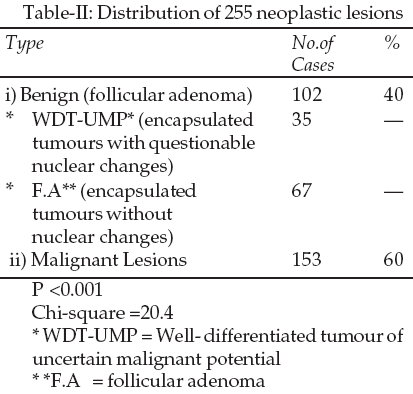
All 102 benign lesions were diagnosed as follicular adenoma as per existing criteria (Fig-2). Out of these, 35 cases showed questionable nuclear changes. On the basis of the recent recommendations by Chernobyl Pathologists Group regarding the handling of encapsulated tumours with follicular architecture, we categorized these 35 cases as well-differentiated tumours of uncertain malignant potential (WDT UMP). The remaining 67 cases were categorized as follicular adenoma, which were without any questionable nuclear changes (Table-II).
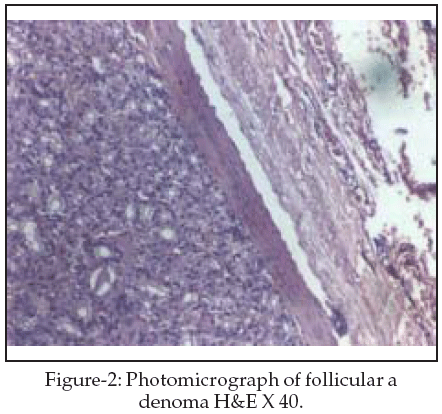
In our study papillary carcinoma (Fig-3) was found to be the commonest malignant thyroid lesion with a total of 138 (90.2%) cases followed by 7(4.5%) cases of medullary carcinoma, 3(2%) cases of follicular carcinoma, 3(2%) cases of undifferentiated carcinoma and 1(0.7%) case each of mixed medullary and papillary carcinoma and poorly differentiated carcinoma (Table-III).
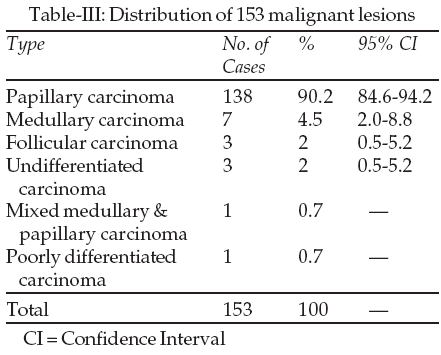
Out of 138 papillary carcinomas, 72 cases were follicular variants followed by 61 cases of classic papillary carcinoma and five cases of micropapillary carcinomas. Of the seven cases of medullay carcinoma, three were follicular variant and one case each of papillary, small cell, paraganglioma like and oncocytic variant of medullary carcinoma was seen.
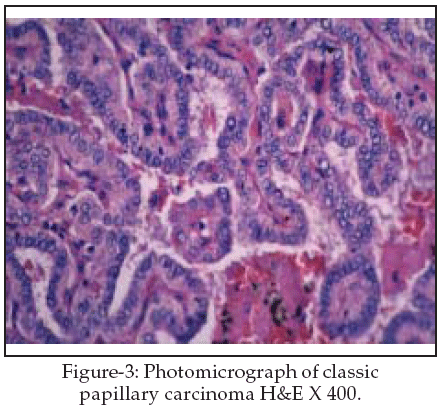
DISCUSSION
The WHO has classified seven percent of world population as suffering from clinically apparent goiter. Most patients are in developing countries, where the disease is attributed to iodine deficiency.
9 The reported incidence of both benign & malignant lesions in surgically treated thyroid swellings varies widely between different geographical areas of the world.10In the present study a general review of thyroid lesions is presented. We found non neoplastic lesions with a frequency of 74% as compared to 26% neoplastic lesions. These results are in agreement with studies of Lahore
11 and Yemen,12 however in Northern Pakistan13 a relatively low frequency (10.5%) of neoplastic lesions was reported as compared to 89.5% non-neoplastic lesions in a series of 581 thyroid biopsies. This could be due to the prevelance of iodine deficiency & a significant number of the cases of multinodular goiter in these areas as compared to the coastal areas.In current study the commonest non-neoplastic lesion was multinodular goiter with a frequency of 91.3%. A comparable high frequency (97.2%) was reported by Ahmed et al
14 in a total of 107 non-neoplastic lesions, while Abu-Eshy et al3 found a relatively lower frequency (70.2%) in his series. We found follicular adenoma as the second common cause of goiter which is in accordance with the findings of, Abu-Eshy et al3 Hussain et al5 and Qureshi et al.15There is no doubt that nuclear morphological appearances changes play a major role in the diagnosis of papillary carcinoma.
16 It is possible that lesions in which the nuclear feature are "questionable" represent an early development of papillary carcinoma in a preexisting benign lesion as suggested by the fact that in microdissection experiments the RET/PTC rearrangements are restricted to these foci.17In our study 102 (40%) cases of follicular adenoma were diagnosed as per existing criteria, which is in accordance with Al-Hureibi et al
12-18 who reported a frequency of 40.1% and 39.8% respectively. Out of our 102 cases, 35 cases showed questionable nuclear changes. Following the recent recommendations by Chernobyl Pathologists Group,6,7 we categorized these cases as well differentiated tumours of uncertain malignant potential.In Turkey Koseoglu et al
19 also followed these reccommendations & categorized two cases of follicular patterned lesions with questionable nuclear changes as WDT-UMP. Total thyroidectomy was performed in those cases. No other study was found for comparison according to the proposals given by Chernobyl Pathologists Group. This might be due to the fact that the use of this nomenclature has not as yet been generally accepted.Variation in the frequency of thyroid carcinomas has been observed in various parts of the world. We found papillary carcinoma as the commonest malignant lesion 90.2%. In USA, Hay
20 & Meier et al21 also reported a similar frequency of papillary carcinoma i-e 90%. Other studies from Lahore,11 Yemen22 & Iran23 have also reported papillary carcinoma as the commonest malignant thyroid tumour with a variable frequency of 57.9%, 93.8% & 69.9% respectively.The observation in the present study may be considered as a baseline data of thyroid diseases in Karachi and a more elaborate prospective study carried out on a large scale throughout country will contribute more to project the exacting profile of thyroid diseases. Such a study will also help in outlining the plans for early detection, diagnosis and management of the thyroid diseases.
The recommendations by Chernobyl Pathologists Group need to be adopted and the cases of WDT-UMP need to separate from common adenomas (encapsulated follicular tumours without nuclear changes) in order to analyze predictive factors and to collect follow-up data that will help physicians and surgeons to manage them in the most appropriate way.
REFERENCES
1. Swati SM, Marco Polo, Goiter. In Man Mountain and Medicine Ilyas M, Khan FA (eds), Pakistan Heart Foundation Peshawar Pakistan 1986;189:14-20.
2. Shaikh Z, Hussain N, Anwar B, Sajjad H, Zubairi A. Thyroid related disorders at Civil Hospital Karachi. Specialist (Pak J Med Sci) 1993;126-8.
3. Abu-Eshy SA, Al-Shehri MY, Khan AR, Khan GM, Al-Humaidi MA, Malatani TS. Causes of goiter in the Asir region. A histopathological analysis of 361 cases. Ann Saudi Med 1995;15:1-3.
4. Hussain N, Anwar M, Nadian N, Ali Z. Pattern of surgically treated thyroid diseases in Karachi. Biomedica 2005;21:18-20.
5. Suster S. Thyroid tumors with a follicular growth pattern: Problems in differential diagnosis. Arch Pathol and Lab Med 2006;130:984-8.
6. Williams ED. Guest Editorial. Two Proposals Regarding the Terminology of Thyroid Tumours. Int J Surg Pathol 2000;8:181-3.
7. Rosai J. Handling of thyroid follicular patterned lesions. Annual meeting, endocrine Pathology society. 2005;1-3.
8. Carcangiu ML, DeLellis RA. Thyroid Gland. In: Anderson’s Pathology. Ed. Damjanov I & Linder J Edn 2000; Philadelphia, 1943-1979.
9. Kally FC, Snedden WW. Bull WHO.1985;18:5-173.
10. Al-Tameem MM. The Pattern of surgical treated thyroid disease in two general hospitals in Riyadh. Saudi Med J 1987;8:61-6.
11. Ahmed I, Malik ML, Ashraf M. Pattern of malignancy in solitary thyroid nodule. Biomedica 1999;15:39-42.
12. Al-Hureibi KA, Abdulmughni YA, Al-Hureibi MA. The epidemiology, pathology and management of goitre in Yemen. Ann Saudi Med 2004;24(2):119-23.
13. Sarfraz T, Khalilullah, Muzaffar M. The frequency and histological types of thyroid carcinoma in Northern Pakistan. Pak Armed Forces Med J 2000;50:98-101.
14. Ahmed M, Ahmed M, Malik Z, Janjua SA. Surgical audit of solitary thyroid nodule. Pak Armed Forces Med J 2001;51:106-110.
15. Qureshi N, Jaffar R, Ahmed N, Nagi WA. Causes of goiter. A morphological analysis. Biomedica 1996;12:54-6.
16. LiVolsi VA. Sugical Pathology of the thyroid, in the series Major Problems in Pathology, WB Saunders Co, Philadelphia, 1990;22:136-72.
17. Fusco A, Chiappetta G, Hui P, Garcia-Rostan G, Golden L, Kinder BK, et al. Assessment of RET/PTC oncogene activation and clonality in thyroid nodules with incomplete morphological evidence of papillary carcinoma. A search for the early precursors of papillary cancer. Am J Pathol 2002;160:1944- 2157.
18. Al-Hureibi AA, QirbiAA, Basha YB. Thyroid swelling in Yemen Arab Republic. Saudi Med J 1990;11:203-7.
19. Koseoglu RD, Filiz No, Aladag I, Eyibilen A, Goven M. Problems encountered in the diagnosis of encapsulated follicular variant of papillary thyroid carcinoma and the morphological diagnostic criteria. Turk J Med Sci 2006;36:17-22.
20. Hay ID. Papillary thyroid carcinoma. Endocrinol Metab Clin North Am 1990;19:545-76.
21. Meier CA. Braveman LE, Fbner SA. Diagnostic use of recombination human thyrotropin in patients with thyroid carcinoma (phase I/II study). J Chin Endocrinol Metab 1994;78:188-96.
22. Abdulmughni YA, Al-Hureibi MA, Al Hureibi KA, Ghafoor MA, Al-Wadan AH. Thyroid cancer in Yemen. Saudi Med J 2004;25:55-9.
23. Larijani B, Mohagheghni MA, Bastanghah MH, Mosavi-Jarrahi AR, Haghpanah V, Tavangar SM, et al. Primary thyroid malignancy in Tehran-Iran. Med Princ Pract 2005;14:396-400.
HOME | SEARCH | CURRENT ISSUE | PAST ISSUES